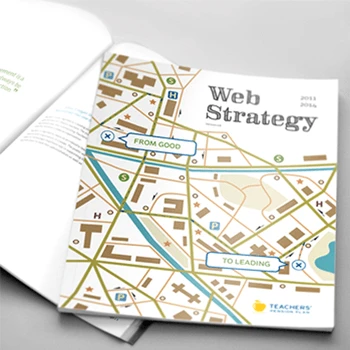What exactly is web user research and why does our website need it?
Web user research uncovers specific insights into how people use your website or portal. We work with you to understand user behavior, needs, and motivations through various research methods. Using our Experience Thinking framework, we examine how users experience your brand, consume content, interact with products, and connect with services through your website.
Tip: Define specific business questions you want research to answer before starting to ensure the study provides actionable insights for your organization.
How does Akendi approach web user research differently?
We take user research as a first step in creating effective designs. Our approach combines behavioral psychology understanding with business affinity, using methods like usability testing, task analysis, contextual inquiry and user observation. Through Experience Thinking, we create personas and usage scenarios that capture intended website use across your entire experience ecosystem.
Tip: Look for research approaches that connect user insights to business strategy rather than just tactical usability improvements.
What business value does web user research provide?
Research provides evidence to prevent costly development mistakes and ensures you build what users actually need. It reduces development budget waste by testing early and often, stops stakeholders from using opinions that result in late changes, and proves what works for users. Research validates product value before significant investment.
Tip: Calculate the cost of building the wrong thing versus the investment in research to make a strong business case for user research.
When should we conduct web user research in our project timeline?
Research should happen early and often throughout development. Test as early as possible with paper prototypes or wireframes when changes are cheap and design alternatives are high. Continue testing through development phases to catch issues before they become expensive to fix. Early research prevents building something users don't want.
Tip: Plan research at multiple project phases rather than just at the end to maximize value and minimize costly changes.
What's the difference between web user research and market research?
Web user research focuses on behavior - how people actually use your website to complete tasks. Market research examines opinions, preferences, and purchasing intentions. User research observes what users do rather than what they say they'll do. We use systematic, behavior-based methods to understand usability and task completion.
Tip: Use user research to understand how people interact with your website and market research to understand what they want from your business offerings.
How does foresight design influence web user research strategy?
Foresight design helps us anticipate future user needs and technology changes that could impact your website experience. We research not just current behavior but explore scenarios that prepare your website for evolving user expectations, emerging technologies, and changing market conditions. This forward-thinking approach ensures research insights remain valuable over time.
Tip: Include questions about future needs and changing contexts in your research to build adaptable rather than just current-state solutions.
What makes web user research different from app or software research?
Web research considers unique browser environments, varying screen sizes, different entry points, and diverse user contexts. Website users often have different goals than app users - they're frequently comparing options, seeking information, or making one-time transactions. Research methods adapt to capture these web-specific behaviors and usage patterns.
Tip: Consider how users discover and access your website differently than dedicated applications when planning research methods and participant recruitment.
What user research methods do you use for websites?
We use user interviews, usability testing, analytics analysis, contextual inquiry, and observational methods to understand website behavior. Methods selection depends on project goals - whether you need task validation, information architecture insights, or broader user understanding. We combine qualitative observation with quantitative data for comprehensive insights.
Tip: Match research methods to specific questions you need answered rather than defaulting to the same approach for every project.
How do you choose between different usability testing approaches?
Method choice depends on product maturity and research goals. Early-stage products benefit from moderated sessions with rich qualitative feedback. Mature products need performance metrics requiring unmoderated testing. Formative testing informs design direction while summative testing measures final performance. We match approach to your development phase and decision needs.
Tip: Define whether you need design feedback or performance measurement before selecting moderated versus unmoderated testing approaches.
What's your approach to user interviews for web projects?
User interviews focus on understanding attitudes, goals, and behavior related to your website domain. We explore demographics, psychographics, domain expertise, and context of use. Interviews inform persona development and reveal mental models that guide information architecture. Questions avoid intentions and focus on actual experiences and behaviors.
Tip: Prepare interview questions that explore past behavior and specific examples rather than hypothetical scenarios or future intentions.
How do you use analytics in user research?
Analytics capture quantitative data about actual website behavior, identifying where usability issues occur and validating qualitative research findings. We track user goals through proper metrics, verify small-sample usability results with broader populations, and identify areas warranting deeper qualitative investigation. Analytics complement rather than replace observational research.
Tip: Define success metrics that align with user goals rather than just business metrics to get meaningful insights from analytics data.
What remote research methods work best for web projects?
Remote research enables testing in natural user environments and accessing geographically diverse participants. Unmoderated testing captures authentic behavior while moderated sessions provide rich qualitative insights. Remote methods work particularly well for website research since users naturally access websites from various locations and devices.
Tip: Use remote research to capture more realistic user contexts while maintaining research quality through proper setup and facilitation techniques.
How do you research mobile versus desktop web experiences?
Mobile and desktop users have different goals, attention spans, and interaction capabilities. We research context-specific needs, test on actual devices rather than simulators, and understand how tasks change across platforms. Research examines both responsive design effectiveness and platform-specific user behavior differences.
Tip: Test mobile experiences on real devices in realistic lighting and network conditions rather than just desktop browser simulations.
What specialized methods do you use for complex websites?
Complex websites require methods like card sorting for information architecture, tree testing for navigation validation, and task analysis for workflow understanding. We use journey mapping to understand multi-session experiences and employ participatory design for stakeholder collaboration. Method complexity scales with website complexity and organizational needs.
Tip: Break complex website research into focused studies addressing specific aspects rather than trying to test everything simultaneously.
How many participants do you typically recruit for web user research?
Participant numbers depend on research method and user diversity. Usability testing typically requires 4-6 participants per user persona, while user interviews need 3 participants per persona for validation. Nielsen and Landauer found 5 participants reveal 85% of usability issues. We balance statistical confidence with budget efficiency.
Tip: Plan multiple small research rounds rather than one large study to enable iterative improvements and better budget utilization.
How do you recruit the right participants for web research?
Recruitment starts with clear participant criteria based on your target audience, domain expertise, and technical comfort levels. We recruit through multiple channels to ensure representative samples and screen for actual website usage patterns rather than just demographics. Proper recruitment is crucial for valid research results.
Tip: Define recruitment criteria based on actual user behaviors and goals rather than just demographic characteristics to get more relevant insights.
What's your typical timeline for web user research projects?
Timeline depends on research scope and method complexity. Simple usability testing takes 2-3 weeks including recruitment, testing, and analysis. Comprehensive research including interviews, testing, and persona development requires 4-6 weeks. We plan for recruitment challenges and analysis time to deliver quality insights.
Tip: Build extra time into research timelines for participant recruitment challenges and thorough analysis rather than rushing to meet arbitrary deadlines.
How do you handle international or multi-market web research?
International research requires understanding cultural differences, local user behavior patterns, and market-specific contexts. We adapt research methods for cultural appropriateness, recruit locally, and consider language and technology differences. Research examines both universal usability principles and market-specific user expectations.
Tip: Partner with local research professionals who understand cultural nuances rather than applying your home market research approach universally.
What preparation do you need from our team before starting research?
We need access to current website analytics, existing user feedback, brand guidelines, and key stakeholder input. Understanding your business goals, user assumptions, and specific research questions helps focus the study. Prototype access or content samples enable realistic testing scenarios.
Tip: Gather existing user feedback and support inquiries before research begins to inform study design and provide baseline context for findings.
How do you ensure research participant safety and privacy?
We follow strict privacy protocols including consent processes, data anonymization, and secure recording storage. Participants understand how their data will be used and can withdraw at any time. Research protocols comply with privacy regulations and industry best practices for ethical research conduct.
Tip: Establish clear data handling and privacy policies upfront to build participant trust and ensure compliance with applicable privacy regulations.
What contingency planning do you have for research challenges?
Research plans include backup participant recruitment, alternative testing methods for technical issues, and flexible scheduling for participant availability. We prepare multiple research scenarios and have protocols for handling equipment failures, participant no-shows, and unexpected findings that require study adaptation.
Tip: Over-recruit participants by 20% and have backup research methods ready to handle inevitable scheduling and technical challenges.
How do you analyze and synthesize web user research data?
Analysis combines behavioral observations, task completion patterns, user feedback, and quantitative metrics. We identify trends across participants, categorize usability issues by severity, and connect findings to business impact. Through Experience Thinking analysis, we examine how research insights affect brand, content, product, and service experiences.
Tip: Analyze research data against your specific business goals and user success metrics rather than just cataloging usability problems.
What deliverables do you provide from web user research?
Deliverables include research findings reports, user personas with usage scenarios, priority-ranked recommendations, and implementation guidance. We provide video highlights, data visualizations, and stakeholder presentations tailored to different audiences. Formats are designed for practical application by your design and development teams.
Tip: Request research deliverables in formats that match your team's workflow and decision-making processes rather than standard report templates.
How do you turn research findings into actionable recommendations?
Recommendations connect research insights to specific design and business decisions. We prioritize findings by user impact and implementation effort, provide clear rationale for each recommendation, and suggest validation approaches. Actionable insights include specific changes rather than general observations about user behavior.
Tip: Ensure research recommendations include implementation priority and resource requirements to facilitate decision-making and planning.
How do you validate research findings across different user groups?
Validation involves comparing findings across user segments, cross-referencing with analytics data, and testing insights with additional participants when needed. We examine whether findings apply broadly or to specific user types and identify patterns that transcend individual participant differences.
Tip: Plan follow-up validation studies for critical findings that will drive major design or business decisions rather than assuming small-sample insights apply universally.
What role does competitive analysis play in your research insights?
Competitive analysis examines how other websites solve similar user problems and identifies industry standards users expect. We analyze competitor approaches to understand user mental models shaped by industry patterns and identify opportunities for differentiation. This context helps interpret user expectations and benchmark findings.
Tip: Include competitive research to understand what users expect based on industry standards while identifying opportunities to exceed those expectations.
How do you present research insights to different stakeholder groups?
Presentations adapt to audience needs - executives get strategic summaries and business impact, designers get detailed usability insights, and developers get implementation-focused findings. We use appropriate language and examples for each audience while maintaining research integrity and actionable recommendations.
Tip: Tailor research presentations to each stakeholder group's decision-making needs rather than presenting the same findings to everyone.
How do you help teams implement research insights effectively?
Implementation support includes design workshops, persona integration training, and ongoing consultation during development. We help translate research insights into design principles, user stories, and acceptance criteria. Support continues through implementation to ensure research insights are preserved in final designs.
Tip: Plan implementation support activities with your development team rather than treating research as a one-time deliverable.
How do you use AI to enhance web user research processes?
AI enhances research through automated transcription, pattern identification in user behavior, and rapid analysis of large datasets. We use AI for initial insight generation and hypothesis development while maintaining human oversight for strategic interpretation. AI helps scale research analysis without replacing the nuanced understanding that experienced researchers provide.
Tip: Implement AI tools to handle time-intensive analysis tasks while keeping human researchers focused on strategic insight interpretation and research design.
What research tools and platforms do you use for web studies?
We use leading research platforms for remote testing, screen recording, analytics integration, and participant management. Tool selection depends on study requirements, participant comfort, and data integration needs. We're experienced with both specialized research tools and standard video conferencing platforms for research sessions.
Tip: Choose research tools based on your specific study requirements and participant technology comfort rather than defaulting to the most advanced options.
How do you ensure research technology doesn't interfere with natural user behavior?
Technology setup focuses on minimal user burden while capturing necessary data. We test recording setups beforehand, provide clear participant instructions, and use familiar technologies when possible. Research protocols account for potential technology impact on user behavior and include backup data collection methods.
Tip: Test your research technology setup with team members before sessions to identify potential user experience issues and technical problems.
What's your approach to mobile web research technology?
Mobile research requires specialized recording tools, device-specific testing setups, and consideration of touch interaction patterns. We test on actual devices rather than simulators and account for real-world mobile usage conditions including network variations and environmental factors.
Tip: Invest in proper mobile research tools and real device testing rather than relying on desktop simulations to capture authentic mobile user behavior.
How do you integrate research data with existing analytics and user data?
Integration combines qualitative research insights with quantitative analytics data to create comprehensive user understanding. We align research findings with existing user metrics, validate small-sample insights against broader data patterns, and identify where qualitative research explains quantitative anomalies.
Tip: Plan data integration approach during research design to ensure compatibility between research insights and existing user data systems.
What emerging technologies are impacting web user research?
Emerging technologies include AI-powered analysis tools, real-time sentiment analysis, automated pattern recognition, and advanced biometric measurement. Foresight design approaches help us anticipate how these technologies will change research methods while maintaining focus on meaningful user insights over technological capability.
Tip: Evaluate emerging research technologies based on their ability to provide actionable insights rather than just technological novelty or capability.
How do you ensure research technology accessibility for diverse participants?
Accessibility planning includes multiple technology options, clear setup instructions, technical support during sessions, and alternative participation methods for users with different technical capabilities. Research design considers digital divide impacts and ensures inclusive participation across user technology comfort levels.
Tip: Provide multiple research participation options and technical support to ensure your research includes users with varying technology access and comfort levels.
How involved will our team need to be during the research process?
Team involvement includes research planning consultation, participant criteria definition, session observation opportunities, and insight interpretation discussions. Your market knowledge and business context enhance research quality. We schedule specific touchpoints where your expertise informs research direction and validates findings.
Tip: Assign dedicated team members with decision-making authority to participate in research activities rather than distributing involvement across many busy stakeholders.
How do you handle stakeholder disagreement about research findings?
Disagreement resolution involves returning to original research objectives, examining evidence quality, and exploring different interpretation perspectives. We facilitate discussions that focus on user evidence rather than opinions and help stakeholders understand how findings connect to their specific concerns and goals.
Tip: Establish research objectives and success criteria upfront with all stakeholders to provide a framework for resolving interpretation disagreements.
What's your approach to project communication and updates?
Communication includes regular progress updates, preliminary findings sharing, and milestone reports throughout the research process. We maintain open communication channels, provide session recordings when appropriate, and ensure stakeholders understand research progress and any adjustments needed.
Tip: Establish communication preferences and frequency expectations at project start rather than assuming default communication approaches work for your team.
How do you help internal teams become more research-informed?
Research democratization involves training team members in basic research principles, providing research templates and guidelines, and establishing quality review processes. We help organizations build internal research capabilities while maintaining standards for research quality and ethical conduct.
Tip: Start with training team members in research observation and analysis skills before expanding to independent research execution.
What's your approach to cross-functional collaboration during research?
Collaboration involves designers, developers, product managers, and business stakeholders in appropriate research phases. Each function contributes unique perspectives during planning and benefits from targeted insight delivery. We coordinate involvement to maximize learning while respecting time constraints and role responsibilities.
Tip: Define clear roles and expectations for cross-functional research involvement rather than assuming everyone needs to participate in everything.
How do you maintain research momentum between studies?
Momentum maintenance includes research roadmap planning, ongoing insight application monitoring, and regular research check-ins with teams. We help establish research rhythms that support continuous learning and user-centered decision making rather than sporadic research activities.
Tip: Plan research as an ongoing capability rather than one-time projects to build organizational research momentum and user-centered culture.
What training do you provide for teams new to user research?
Training covers research fundamentals, observation techniques, insight interpretation, and research integration into existing workflows. We provide practical workshops, research observation opportunities, and ongoing consultation to help teams develop user research capabilities appropriate to their roles and responsibilities.
Tip: Focus initial training on research consumption and application skills rather than research execution to build organization-wide research appreciation.
How do you measure the ROI and impact of web user research?
ROI measurement includes reduced development costs from early issue identification, improved conversion rates from better user experiences, decreased support costs from more usable designs, and faster time-to-market from confident design decisions. We help establish measurement frameworks connecting research to business outcomes.
Tip: Establish baseline metrics before research begins to demonstrate concrete impact on business performance and user experience quality.
What metrics indicate successful web user research outcomes?
Success metrics include improved task completion rates, reduced user errors, increased user satisfaction scores, higher conversion rates, and decreased support inquiries. Through Experience Thinking measurement, we track how research improves brand perception, content engagement, product interaction, and service connection.
Tip: Define success metrics that align with your business goals rather than just usability improvements to demonstrate research value to stakeholders.
How often should we conduct web user research?
Research frequency depends on website change velocity, user feedback patterns, and business growth. Many organizations benefit from quarterly research reviews with annual comprehensive studies. Foresight design approaches help anticipate when research updates become necessary based on changing user expectations and technology.
Tip: Establish regular research review cycles tied to your product development rhythm rather than waiting for user experience problems to emerge.
What ongoing optimization do you recommend after initial research?
Ongoing optimization includes continuous user feedback collection, targeted research on specific website areas, validation of implemented changes, and research updates as user needs evolve. We establish processes enabling regular enhancement without requiring complete research overhauls.
Tip: Implement lightweight research methods for ongoing optimization rather than repeating comprehensive studies for every website improvement.
How do you demonstrate research value to stakeholders who are skeptical about user research?
Value demonstration includes concrete examples of research preventing costly mistakes, quantified improvements from research-informed design changes, and comparison of research-informed versus assumption-based decisions. We provide evidence in business terms stakeholders understand and connect to their specific concerns.
Tip: Start with small, high-impact research studies that demonstrate clear value rather than trying to convince skeptics with large, comprehensive research projects.
What's your approach to building long-term research capabilities?
Long-term capability building includes establishing research processes, training internal advocates, creating research documentation systems, and developing organizational research culture. We help organizations move from project-based research to research-informed culture that supports continuous user-centered improvement.
Tip: Invest in building internal research advocates and basic capabilities rather than relying entirely on external research services for long-term sustainability.
How do you ensure web user research insights remain relevant over time?
Relevance maintenance involves regular insight validation, tracking user behavior changes, monitoring industry developments, and updating research based on evolving user expectations. Foresight design principles help anticipate when research insights need refreshing and identify emerging user needs before they become critical.
Tip: Create systems for monitoring user behavior changes and industry trends rather than assuming research insights remain valid indefinitely.












